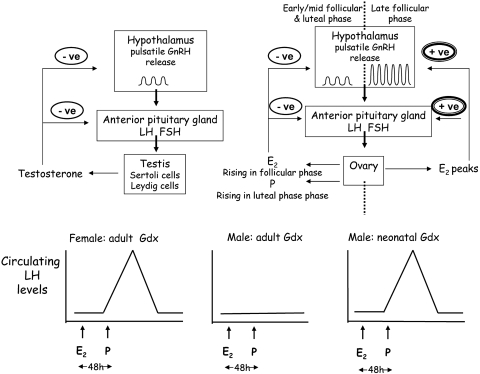Fig. 2.
Adult sexually dimorphic circuitry is imprinted by neonatal hormone action. In the adult male HPG axis (A), GnRH is released from hypothalamic neurons in a pulsatile manner to stimulate the release of LH and follicle-stimulating hormone (FSH), which in turn stimulate testosterone (T) production and spermatogenesis. T exerts a negative feedback (-ve) at hypothalamic and pituitary levels to maintain a steady state in the hypothalamo-pituitary-gonadal axis. In females (B), estradiol (E2) and progesterone (P) produced by the ovaries also exert a negative feedback in the early follicular phase and luteal phase, respectively, of the menstrual cycle, but in the late follicular phase, as E2 levels peak, this converts to a positive feedback (+ve), which augments GnRH release and triggers an LH surge and ovulation at mid-cycle. In gonadectomized female rats (C), activation of the LH surge can be induced experimentally by the injection of E2 followed 48 h later by P. In male rats gonadectomized as adults (D), the hypothalamic circuitry, and hence the LH surge, fails to respond to hormonal priming, whereas the LH surge can be induced in adult male rats if they were gonadectomized as newborns (E). These and related studies demonstrate that early exposure to T, after its aromatization to E2, suppresses the circuitry responsible for the positive feedback of E2 on GnRH release.

